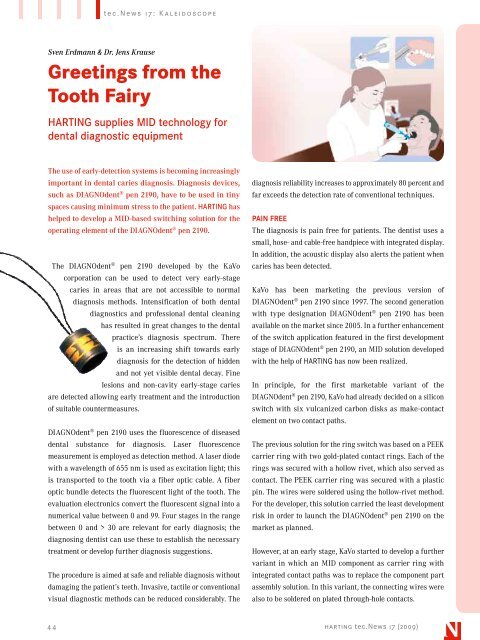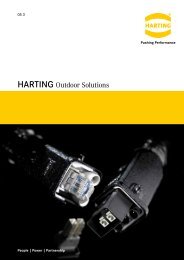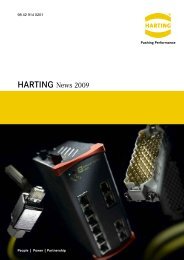Download - Harting
Download - Harting
Download - Harting
Create successful ePaper yourself
Turn your PDF publications into a flip-book with our unique Google optimized e-Paper software.
tec.News 17: Kaleidoscope<br />
Sven Erdmann & Dr. Jens Krause<br />
Greetings from the<br />
Tooth Fairy<br />
HARTING supplies MID technology for<br />
dental diagnostic equipment<br />
The use of early-detection systems is becoming increasingly<br />
important in dental caries diagnosis. Diagnosis devices,<br />
such as DIAGNOdent® pen 2190, have to be used in tiny<br />
spaces causing minimum stress to the patient. HARTING has<br />
helped to develop a MID-based switching solution for the<br />
operating element of the DIAGNOdent® pen 2190.<br />
The DIAGNOdent® pen 2190 developed by the KaVo<br />
corporation can be used to detect very early-stage<br />
caries in areas that are not accessible to normal<br />
diagnosis methods. Intensification of both dental<br />
diagnostics and professional dental cleaning<br />
has resulted in great changes to the dental<br />
practice’s diagnosis spectrum. There<br />
is an increasing shift towards early<br />
diagnosis for the detection of hidden<br />
and not yet visible dental decay. Fine<br />
lesions and non-cavity early-stage caries<br />
are detected allowing early treatment and the introduction<br />
of suitable countermeasures.<br />
DIAGNOdent® pen 2190 uses the fluorescence of diseased<br />
dental substance for diagnosis. Laser fluorescence<br />
measurement is employed as detection method. A laser diode<br />
with a wavelength of 655 nm is used as excitation light; this<br />
is transported to the tooth via a fiber optic cable. A fiber<br />
optic bundle detects the fluorescent light of the tooth. The<br />
evaluation electronics convert the fluorescent signal into a<br />
numerical value between 0 and 99. Four stages in the range<br />
between 0 and > 30 are relevant for early diagnosis; the<br />
diagnosing dentist can use these to establish the necessary<br />
treatment or develop further diagnosis suggestions.<br />
The procedure is aimed at safe and reliable diagnosis without<br />
damaging the patient’s teeth. Invasive, tactile or conventional<br />
visual diagnostic methods can be reduced considerably. The<br />
diagnosis reliability increases to approximately 80 percent and<br />
far exceeds the detection rate of conventional techniques.<br />
Pain free<br />
The diagnosis is pain free for patients. The dentist uses a<br />
small, hose- and cable-free handpiece with integrated display.<br />
In addition, the acoustic display also alerts the patient when<br />
caries has been detected.<br />
KaVo has been marketing the previous version of<br />
DIAGNOdent® pen 2190 since 1997. The second generation<br />
with type designation DIAGNOdent® pen 2190 has been<br />
available on the market since 2005. In a further enhancement<br />
of the switch application featured in the first development<br />
stage of DIAGNOdent® pen 2190, an MID solution developed<br />
with the help of HARTING has now been realized.<br />
In principle, for the first marketable variant of the<br />
DIAGNOdent® pen 2190, KaVo had already decided on a silicon<br />
switch with six vulcanized carbon disks as make-contact<br />
element on two contact paths.<br />
The previous solution for the ring switch was based on a PEEK<br />
carrier ring with two gold-plated contact rings. Each of the<br />
rings was secured with a hollow rivet, which also served as<br />
contact. The PEEK carrier ring was secured with a plastic<br />
pin. The wires were soldered using the hollow-rivet method.<br />
For the developer, this solution carried the least development<br />
risk in order to launch the DIAGNOdent® pen 2190 on the<br />
market as planned.<br />
However, at an early stage, KaVo started to develop a further<br />
variant in which an MID component as carrier ring with<br />
integrated contact paths was to replace the component part<br />
assembly solution. In this variant, the connecting wires were<br />
also to be soldered on plated through-hole contacts.<br />
44 harting tec.News 17 (2009)





